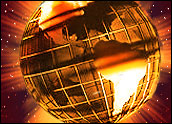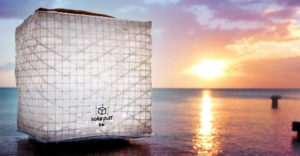
The CERN team in Switzerland uses the Large Hadron Collider to search for the elusive Higgs-Boson. A small team of researchers led by Larry Hunter, a professor of physics at Amherst College, can top them in one aspect; they are using the entire planet as a particle detector that could open up new areas of physics.
Those areas could include something called the “unparticle,” which may be associated with a possible fifth force of nature active deep within the Earth’s mantle. The team, which published the findings of their work Thursday in the journal Science, could help rewrite the rules of science if these subatomic materials are discovered.

Many models of particle physics that extend the Standard Model — gravity, weak, strong and electromagnetic, the four known forces that make up the fundamentals of nature — predict the existence of long-range spin-spin interactions. Hunter’s team proposes using the Earth as a polarized spin source to investigate these still-hypothetical interactions.
“What we have done is to look for the long-range spin-spin interaction using a new and more sensitive technique,” Hunter told TechNewsWorld. This work could give scientists a clearer window into the planet’s composition.
“I find it somewhat novel that they plan to use the Earth as a test bed for a physics-based conjecture, in contrast with the more common situation wherein physics is employed to better understand the nature of the Earth,” said William Newman, professor of earth and space sciences at the University of California at Los Angeles.
“It is not every day,” he said, “that we see such a creative approach to solving a fundamental problem in physics.”
Long-Range Spinning
Every particle – electrons, neutrons and protons – has what physicists call spin. This is one of two types of angular momentum in quantum mechanics; the other is orbital angular momentum.
Ice skaters who are spinning increase the rate of their spin by bringing their arms closer to their bodies to conserve angular momentum.
Earth’s magnetic field causes the spins in some of the electrons in its mantle — that part between its outer crust and its central core — to become spin-polarized, meaning their spins begin pointing in a particular direction.
Experiments conducted by Hunter’s team indicated there might be another force beyond magnetism that polarized spins in the lab. This other force — the possible fifth force? — could be behind the long-range interaction between the spins in the team’s apparatus and the electron spins within the earth.
The long-range spin-spin interaction remains theoretical for now, and Hunter’s team infers it might be up to one million times weaker than the gravitational attraction between the particles.
Searching for the Spin
Hunter’s team took a model of the Earth’s interior based partially on studies of spin transitions conducted by team member Jung-Fu Lin, an associate professor of geosciences at the University of Texas at Austin.

They combined this model with a precise map of the planet’s geomagnetic field. This gave the team the first-ever comprehensive map of the magnitude and direction of electron spins throughout Earth induced by the planet’s geomagnetic field.
“If one discovered and understood a long-range spin-spin interaction, you could turn around the methods we use in our manuscript and use the force to probe electron spins in the mantle,” Hunter said. This would be accomplished by making observations from various points around the planet with several different orientations of the apparatus.
Such measurements would provide “fairly direct information about the iron densities in the deep mantle,” Hunter said.
The team’s investigations and result “should be taken very seriously,” Newman told TechNewsWorld. “They have provided an authoritative theoretical treatment of the problem which does conform with the standard model, and can be tested to identify the strength of the interaction by experiment.”
Beyond the Higgs Boson Horizon
Despite its search for previously undiscovered particles and forces, the team’s research doesn’t have any connection with the hunt for the elusive Higgs Boson — the so-called “God particle.”
“The Higgs Boson is a prediction of the Standard Model of particle physics,” Hunter said. “The proposed particles that are responsible for long-range spin-spin interaction are beyond the standard model.”
The long-range spin-spin interaction is not related to quantum entanglement either, he added.
Quantum entanglement occurs when particles such as photons, electrons or molecules interact physically and then become separated. When a measurement made of one member of an entangled pair of particles causes it to take on a value such as a clockwise spin, the other member of the pair will take on the opposite value — in this case a counterclockwise spin — even though the two are separated by very large distances.






















































"undiscovered particles and forces"
To me, the future will give good results. In my opinion. I have eight pieces of the fundamental forces. That’s the first installment of "The New Paradigm of Scientific Improving" http://www.mehmetkececi.com/index.php?option=com_content&view=article&id=267&Itemid=939